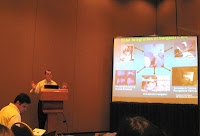BioRob – Surgical robotics workshop
 The 2nd IEEE/RAS – EMBS BioRob conference began with a full day workshop on surgical robotics. The invited speakers covered many areas; however, it was still more of a series of podium talks.
The 2nd IEEE/RAS – EMBS BioRob conference began with a full day workshop on surgical robotics. The invited speakers covered many areas; however, it was still more of a series of podium talks.Richard Satava, probably the greatest visionary of the field began the presentations by showing up the technologies already in reach to improve health care. As he pointed, “we are moving from the tissue and instrument to the information and energy”, meaning that not the tool is the important (robot, or smart device) but the framework it fits. Some of his presentations are available here, showing HIFU focusing robots, femto-lasers, surface manipulation based HMIs and many other interesting things. Some of his videos are also available zipped (VIDEO1; VIDEO2).
Next, Gary Gilbert from DARPA presented the military’s view on the future of battlefield healthcare. Current law determines that by 2015 one third of the US army should consist of automated vehicles, and by 2035 there shall be no more human aircraft pilots flying. This tight roadmap explains the military’s key interest in robotic technologies. A good example is the Big Dog four-pied robot. More time was spent on the introduction of the BEAR (Battlefield Extraction Assist Robot) rescue robot that is capable of evacuating soldiers (lifting and balancing up to 260 kg).
Further talks covered the successful zero-G surgical robotic tests of NASA, the hand-held tremor filtering surgical tool developed at Carnegie Melon, the magnetic-suspended abdominal self-assembling robots of University of Nebraska, the video image based beating heart analysis and compensation of the LIRMM and other major ongoing research projects. From Hopkins, Dr. Taylor presented how the CISST ERC covers the entire field of CIS; from imaging, planning to registration, execution and evaluation. Dr. Okamura talked in details the ongoing haptic, tactile and needle-steering projects undertaken in her lab.
The workshop ended with a short open discussion where the participants agreed on two major absences of the field. First, a standard performance evaluation scale and method would be needed to measure surgical systems, robots and technologies in an objective scale. This could be a set of key surgical skills and gestures along with standard measurement techniques. Also, it would be great to have a generic, multi-purpose, affordable open source, open platform hardware to prototype, test and evaluate new solutions, making them comparable, and saving the time of separate testbed development.


Comments